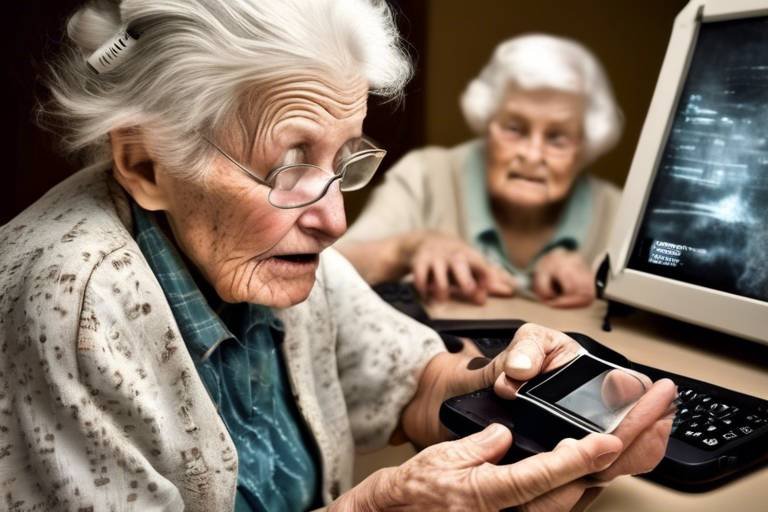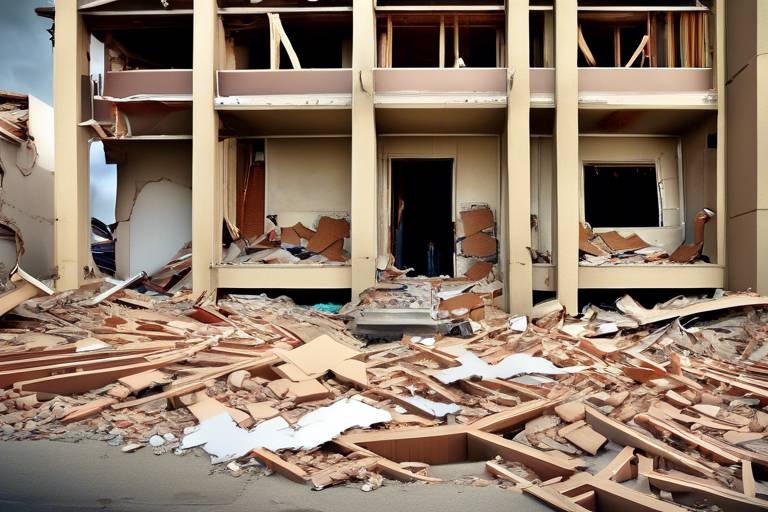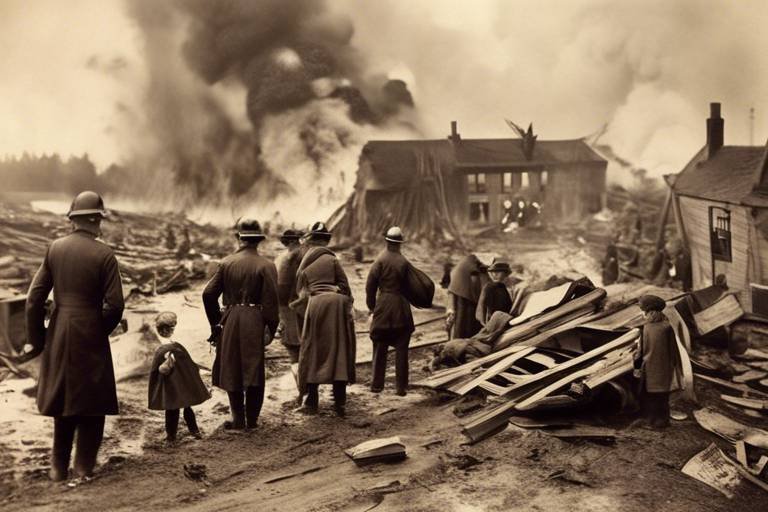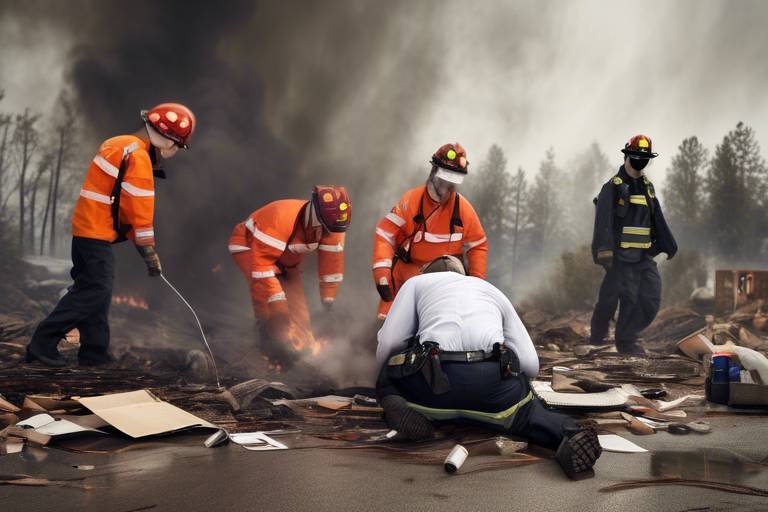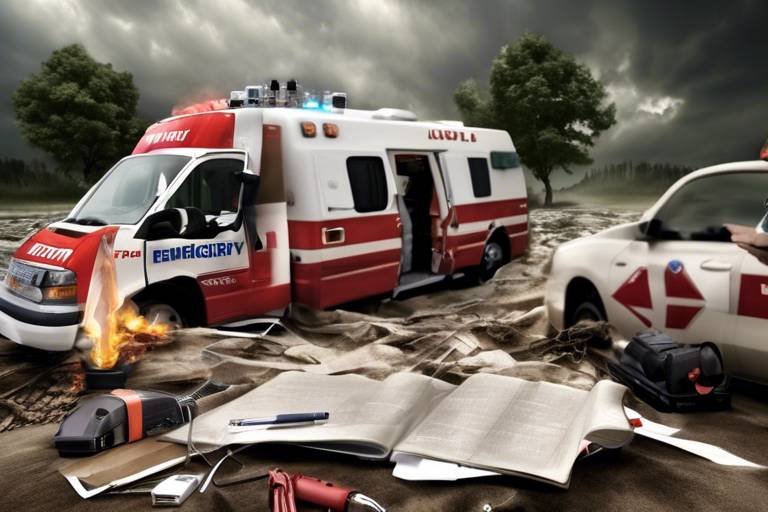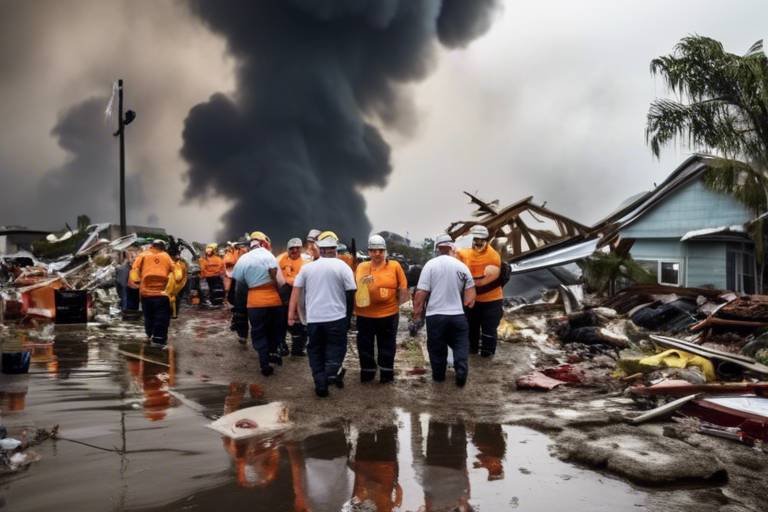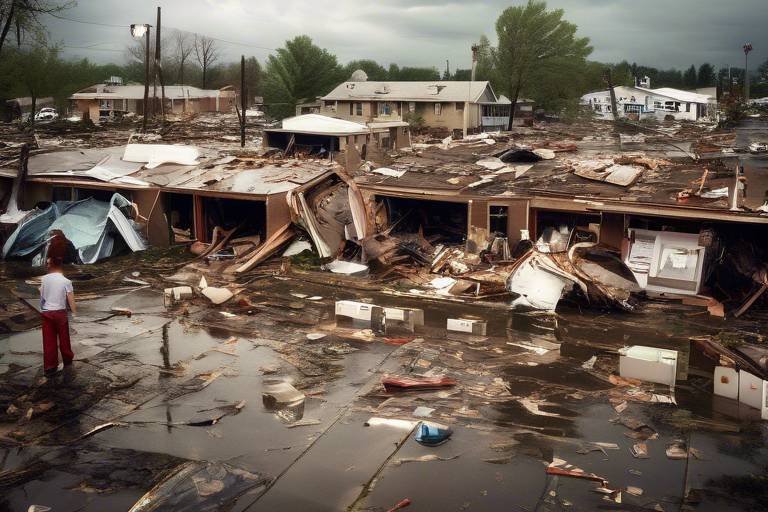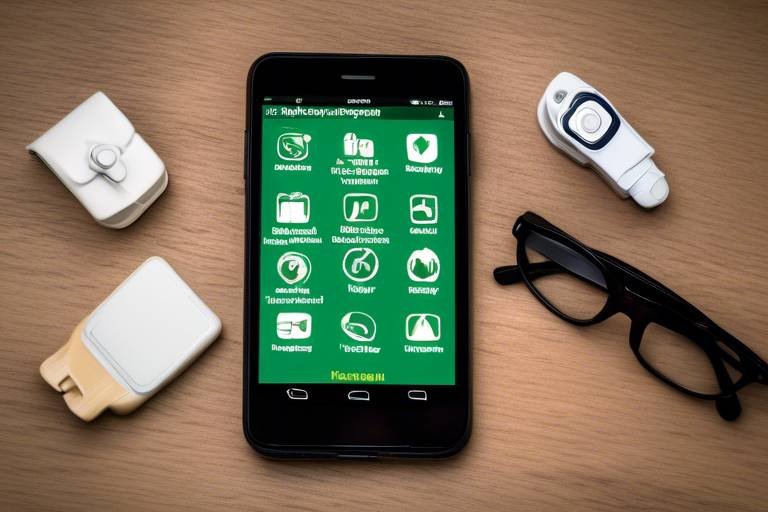Teaching the Elderly about Technology for Disaster Preparedness
This article explores effective methods to educate elderly individuals on utilizing technology for disaster preparedness, ensuring their safety and enhancing their confidence in emergency situations.
In today's world, technology is not just a luxury; it's a necessity, especially when it comes to disaster preparedness. For the elderly, who may find themselves feeling overwhelmed by the rapid pace of technological advancements, understanding how to harness these tools can be life-saving. Imagine being able to receive real-time updates during a natural disaster or having access to emergency contacts at the touch of a button. This is where technology steps in as a powerful ally. It can help them stay informed, connected, and prepared, transforming what could be a chaotic experience into a manageable one.
Before diving into the world of technology, it’s crucial to assess the existing technological skills of elderly individuals. This evaluation allows us to tailor education programs that meet their specific needs and capabilities. Just like a tailor measures fabric to create a perfect fit, we need to gauge their comfort level with devices and applications. Some may have a basic understanding of smartphones, while others might struggle with the simplest tasks. This personalized approach ensures effective learning and engagement, making it easier for them to grasp the essentials of disaster preparedness.
When it comes to learning new technologies, elderly individuals often face several challenges. These challenges can be likened to hurdles on a racetrack—some are small and easily overcome, while others can feel like insurmountable barriers. Common issues include:
- Physical Limitations: Poor eyesight or limited dexterity can make using devices difficult.
- Cognitive Barriers: Memory issues or difficulty understanding complex instructions can hinder the learning process.
- Fear of Technology: Many elderly individuals may feel intimidated by new gadgets, leading to reluctance in using them.
To accommodate physical challenges, such as poor eyesight or limited dexterity, we can implement several strategies during technology training. For instance, using devices with larger screens and adjustable text sizes can significantly enhance visibility. Additionally, incorporating voice-activated features can alleviate the need for intricate finger movements, making technology more accessible. By creating an inclusive environment that considers these physical limitations, we empower elderly learners to engage confidently with technology.
When cognitive barriers arise, simplifying instructions becomes paramount. Think of it like teaching someone to ride a bike; you wouldn’t start with advanced tricks. Instead, break down the learning process into small, manageable steps. Use clear, concise language and incorporate visual aids whenever possible. Repetition also plays a key role in enhancing retention. By reinforcing concepts through hands-on practice and consistent review, we can help elderly learners feel more comfortable and confident in their abilities.
A supportive learning environment is vital for encouraging elderly individuals to engage with technology. This means fostering a space where they feel safe to ask questions and make mistakes. Just like a warm and inviting classroom makes learning more enjoyable, a supportive atmosphere can significantly enhance the learning experience. Encourage group learning sessions where peers can share their experiences and tips, creating a sense of community and collaboration.
When selecting technology for disaster preparedness, it's essential to prioritize user-friendly options specifically designed for the elderly. Imagine a smartphone that not only has large buttons but also features voice commands and simplified interfaces. Such technology can make learning less daunting and more enjoyable. By focusing on accessibility, we can help elderly individuals navigate the digital landscape with ease, ensuring they can effectively utilize these tools in times of need.
There are several apps and tools available that can assist the elderly in disaster preparedness. Here’s a quick overview of some recommended options:
| App/Tool | Description | Features |
|---|---|---|
| Red Cross Emergency App | Provides real-time alerts and safety information. | Emergency kit checklist, safety tips, and local emergency contacts. |
| Life360 | Family locator app that shares location with loved ones. | Location sharing, emergency alerts, and driving safety features. |
| MyRadar | Weather radar app that shows real-time weather updates. | Interactive radar, severe weather alerts, and customizable notifications. |
Hands-on practice is crucial for reinforcing learning. Just like learning to swim, you can’t just read about it—you have to get in the water! Organizing practical sessions where elderly individuals can apply what they have learned in a safe environment not only builds their confidence but also solidifies their understanding. Encourage them to practice using the recommended apps and tools, allowing them to familiarize themselves with the technology before an emergency arises.
Q: What if the elderly individual has never used technology before?
A: Start with the basics! Introduce them to simple devices and gradually build their skills.
Q: How can I help them feel more comfortable with technology?
A: Patience is key. Encourage them, celebrate small victories, and create a relaxed learning atmosphere.
Q: Are there specific classes available for elderly individuals?
A: Yes! Many community centers and libraries offer technology classes tailored for seniors.
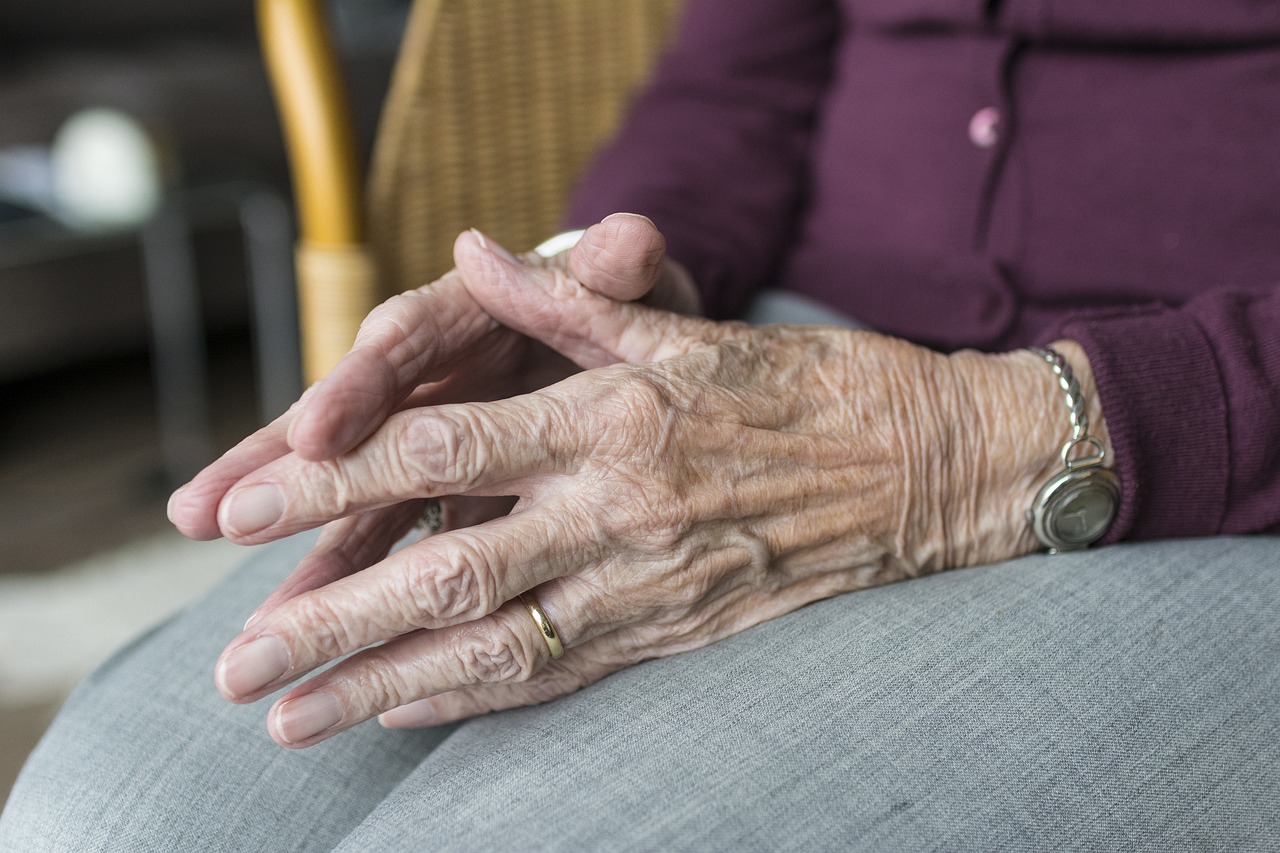
Understanding the Importance of Technology
This article explores effective methods to educate elderly individuals on utilizing technology for disaster preparedness, ensuring their safety and enhancing their confidence in emergency situations.
In today's fast-paced world, technology is not just a luxury—it's a necessity, especially when it comes to disaster preparedness. For the elderly, who may feel overwhelmed by the rapid advancements in technology, understanding its importance can be a game-changer. Imagine being in a situation where a natural disaster strikes, and you have the tools at your fingertips to stay safe and informed. This is where technology becomes a lifeline, providing access to essential information and resources.
Consider this: technology can help the elderly receive timely alerts about emergencies, communicate with loved ones, and access critical services. For instance, smartphones and tablets can be equipped with applications that provide real-time weather updates or emergency notifications. These tools can significantly enhance their ability to respond effectively during a crisis. Moreover, technology can bridge the gap between isolation and connection, allowing elderly individuals to engage with their community and family, which is vital during emergencies.
However, it's essential to recognize that many elderly individuals may not be familiar with these tools. They might view technology as daunting or even intimidating. To combat this perception, we must emphasize the benefits of technology in a way that resonates with them. Here are some key points to consider:
- Increased Safety: Technology can provide alerts and updates during disasters, ensuring that elderly individuals are always informed.
- Improved Communication: Staying connected with family and friends can be crucial during emergencies, and technology facilitates this connection.
- Access to Resources: Online platforms can offer valuable information about local shelters, medical services, and emergency contacts.
By understanding the importance of technology, elderly individuals can begin to see it not as a barrier but as a tool that empowers them. Just like learning to ride a bike, it may seem challenging at first, but with a little practice and guidance, it can lead to newfound freedom and confidence. The journey to embracing technology will not only enhance their disaster preparedness but also enrich their daily lives.
Evaluating the existing technological skills of elderly individuals is essential for tailoring education programs that meet their specific needs and capabilities, ensuring effective learning and engagement.
This subsection discusses the common challenges faced by the elderly when learning new technologies, such as physical limitations, cognitive barriers, and fear of technology.
Physical challenges, such as poor eyesight or limited dexterity, can hinder the learning process. This section offers strategies to accommodate these limitations during technology training.
Cognitive barriers can impede understanding. Here, we explore techniques to simplify instructions and enhance retention for elderly learners.
A supportive learning environment is vital for encouraging elderly individuals to engage with technology. This section outlines best practices for fostering such an atmosphere.
This part emphasizes the importance of selecting user-friendly technology that is specifically designed for the elderly, making it easier for them to learn and apply disaster preparedness techniques.
Here, we provide a list of recommended apps and tools that can assist the elderly in disaster preparedness, focusing on simplicity and accessibility.
Hands-on practice is crucial for reinforcing learning. This section discusses the benefits of practical sessions where elderly individuals can apply what they have learned in a safe environment.
In this section, we will address some common questions regarding teaching the elderly about technology for disaster preparedness.
- What are the best ways to introduce technology to the elderly? Start with simple devices and applications, demonstrating their practical uses in everyday scenarios.
- How can I make learning technology less intimidating for seniors? Use relatable analogies and hands-on practice to build their confidence gradually.
- What types of technology are most beneficial for disaster preparedness? Smartphones, tablets, and dedicated emergency apps are highly recommended for their accessibility and functionality.

Assessing Technological Skills
When it comes to teaching the elderly about technology, one of the most crucial steps is assessing their existing technological skills. This evaluation is not just a formality; it's the foundation upon which effective education programs are built. Think of it as laying the groundwork for a sturdy house—without a solid base, everything else can crumble. By understanding where they stand, we can tailor our approach to meet their specific needs and capabilities, ensuring that the learning experience is both engaging and effective.
But how do we go about this assessment? Start by having open conversations with the elderly individuals. Ask them about their previous experiences with technology. Have they used a smartphone or a computer? Do they feel comfortable sending emails or browsing the internet? These questions can help you gauge their comfort level and identify areas that may need more focus. Additionally, consider using simple assessments or questionnaires designed specifically for the elderly to evaluate their skills in a non-threatening manner. This can include tasks like:
- Turning on a device
- Navigating a touchscreen
- Sending a text message
- Using a search engine
Once you have a clear understanding of their skill levels, you can begin to create a structured plan that addresses their unique challenges and learning styles. This is where the magic happens! By customizing your approach, you not only enhance their learning experience but also boost their confidence. Remember, the goal is to make technology feel less like a daunting mountain to climb and more like a friendly hill they can stroll up at their own pace.
It's also essential to recognize that not all elderly individuals will have the same starting point. Some may be tech-savvy, having embraced smartphones and social media, while others may struggle with basic functions. This diversity necessitates a flexible teaching strategy. For instance, you might need to implement different teaching methods for those who are more visually inclined versus those who learn better through hands-on experience. The key is to keep the environment supportive and encouraging, allowing them to learn from their mistakes without fear of judgment.
Incorporating technology assessments into your program not only helps in identifying skill levels but also in tracking progress over time. As elderly learners begin to grasp new concepts, it's important to celebrate their achievements, no matter how small. This positive reinforcement can significantly enhance their motivation and willingness to engage with technology. After all, learning should be a joyful journey, not a stressful chore!
In summary, assessing technological skills is a vital step in preparing elderly individuals for disaster preparedness through technology. By understanding their current capabilities, customizing the learning experience, and fostering a supportive environment, we can empower them to embrace technology with confidence. Now, let’s dive deeper into some of the common challenges they face when learning these new skills.

Identifying Common Challenges
When it comes to teaching the elderly about technology, it's essential to recognize the common challenges they face. Many seniors feel overwhelmed by the rapid pace of technological advancement, which can lead to frustration and anxiety. Imagine stepping into a bustling city for the first time, surrounded by unfamiliar sights and sounds; this is how many elderly individuals feel when confronted with new gadgets and applications. It's crucial to identify these challenges to tailor our approach effectively.
One significant barrier is physical limitations. As we age, our bodies change, and tasks that once seemed simple can become daunting. For instance, seniors may struggle with poor eyesight, making it difficult to read small text on screens or identify icons. Additionally, limited dexterity can hinder their ability to navigate touchscreens or manipulate small buttons. Addressing these physical challenges is paramount in helping them engage with technology.
Another hurdle is the cognitive barriers that many elderly individuals encounter. Cognitive decline can affect memory, attention span, and processing speed, making it challenging to grasp new concepts. Just like a sponge that can only absorb so much water at a time, seniors may find it difficult to retain information when it's presented too quickly or in complex terms. Simplifying instructions and providing ample repetition can help overcome these barriers.
Moreover, the fear of technology is a prevalent issue. Many elderly individuals grew up in a time when technology was not a daily part of life. This unfamiliarity can breed apprehension. They might worry about making mistakes or breaking something, which can lead to avoidance. It's vital to create an environment where they feel safe to explore and learn without the fear of judgment or failure.
In summary, understanding and identifying these common challenges—physical limitations, cognitive barriers, and fear of technology—are the first steps toward creating effective educational programs. By addressing these issues head-on, we can empower elderly individuals to embrace technology, enhancing their confidence and ensuring their safety in disaster preparedness.
- What are some effective ways to teach technology to the elderly? It's essential to use simple language, provide hands-on practice, and create a supportive environment.
- How can I make technology more accessible for seniors? Choose user-friendly devices and applications, and consider their physical and cognitive limitations when introducing new tools.
- What should I do if a senior feels overwhelmed by technology? Break down tasks into manageable steps, offer encouragement, and ensure they have plenty of time to practice.
- Are there specific tools designed for elderly users? Yes, many apps and devices are tailored to be more intuitive and accessible for seniors, focusing on simplicity and ease of use.

Addressing Physical Limitations
When it comes to teaching the elderly about technology, one of the most significant hurdles we face is addressing their physical limitations. Many older adults experience challenges such as diminished eyesight, reduced dexterity, and even arthritis, which can make interacting with devices a daunting task. Imagine trying to navigate a smartphone with stiff fingers or reading tiny text on a screen that seems to blur with every glance. This scenario is all too common, and it’s crucial that we find ways to accommodate these physical challenges to foster a more inclusive learning environment.
To effectively teach technology, we need to consider the various ways we can adapt our teaching methods and the tools we use. For instance, using devices with larger screens can significantly enhance visibility. Tablets, for example, often come with adjustable font sizes and high-contrast settings that can be tailored to individual needs. Furthermore, utilizing voice-activated technology can alleviate the need for intricate finger movements, allowing users to interact with their devices more comfortably. These adaptations not only make learning easier but also empower elderly individuals by boosting their confidence in using technology.
Additionally, it's essential to create a comfortable learning space. This means ensuring that seating is supportive and that the environment is well-lit. A cozy, inviting atmosphere can help reduce anxiety and encourage elderly learners to engage more fully with the material. Consider implementing the following strategies:
- Use of Assistive Devices: Tools like styluses can help those with limited dexterity navigate touchscreens more easily.
- Adjustable Settings: Encourage learners to customize their devices, such as increasing text size or utilizing screen readers.
- Frequent Breaks: Allow for regular breaks during learning sessions to prevent fatigue and discomfort.
Moreover, patience is key. It's important to recognize that learning new technology can be a frustrating experience for many elderly individuals. By taking the time to slow down and provide clear, step-by-step instructions, we can help ease their fears and build their skills. Remember, it's not just about teaching them how to use a device; it's about instilling a sense of independence and self-sufficiency that can enhance their overall quality of life.
In conclusion, addressing physical limitations in elderly learners requires a multifaceted approach that combines thoughtful adaptations of technology with a supportive and patient teaching style. By making these adjustments, we can help older adults not just learn how to use technology, but also feel confident and capable in an increasingly digital world.
Q: What types of devices are best for elderly learners?
A: Devices with larger screens, such as tablets, are typically more user-friendly for elderly individuals. Look for options with adjustable settings for text size and contrast.
Q: How can I help someone with poor eyesight use technology?
A: Encourage them to adjust the display settings for larger text and high contrast. Additionally, consider using voice-activated technology to minimize the need for reading small text.
Q: What should I do if someone feels frustrated while learning?
A: Patience is essential. Offer encouragement, take breaks, and simplify instructions to help them feel more at ease.

Overcoming Cognitive Barriers
When it comes to teaching the elderly about technology, one of the most significant hurdles we face is the cognitive barriers that can make learning new skills feel like climbing a mountain. Many older adults may struggle with memory retention, processing speed, and even the anxiety that comes with trying to grasp unfamiliar concepts. It's essential to recognize that these challenges are not a reflection of their intelligence but rather a natural part of aging. So, how do we make technology more accessible and less intimidating for them?
First and foremost, simplifying instructions is key. Instead of bombarding them with a plethora of information at once, we should break down the learning process into manageable chunks. For instance, when introducing a new app, we can focus on one feature at a time. This method not only makes it easier to digest but also allows for more hands-on practice, reinforcing their understanding. Think of it like teaching someone to ride a bike; you wouldn’t throw them into a race right away. You’d start with balancing, then pedaling, and finally steering.
Additionally, using visual aids can greatly enhance comprehension. Many elderly learners respond well to diagrams, charts, and even videos. A well-placed image can often convey a concept much faster than words alone. For example, creating a simple flowchart that outlines the steps for using an emergency contact app can provide a clear roadmap for them to follow.
Another effective strategy is to encourage peer learning. When elderly individuals learn from each other, it fosters a sense of community and reduces the intimidation factor. They might feel more comfortable asking questions or expressing confusion when they’re in a group of their peers. This not only enhances learning but also builds confidence as they navigate technology together.
Lastly, we must be patient and understanding. It’s crucial to create an atmosphere where mistakes are viewed as a natural part of the learning process. Encourage them to experiment without the fear of making errors. Remind them that every tech whiz started as a beginner. By doing this, we can help to dismantle the cognitive barriers that often hold them back, empowering them to embrace technology for their disaster preparedness.
- What are some common cognitive barriers faced by the elderly? Many elderly individuals may experience challenges with memory retention, slower processing speeds, and anxiety related to learning new technologies.
- How can visual aids help in teaching technology? Visual aids such as diagrams and videos can simplify complex concepts and enhance understanding, making it easier for elderly learners to grasp new information.
- Why is peer learning effective for the elderly? Learning in a group setting allows elderly individuals to feel supported and less intimidated, fostering a sense of community and encouraging open communication.
- How important is patience in teaching technology? Patience is crucial as it creates a safe learning environment where mistakes are accepted, allowing learners to feel more confident in their abilities.

Creating a Supportive Learning Environment
When it comes to teaching the elderly about technology, is absolutely essential. Imagine stepping into a classroom where the air is filled with encouragement, understanding, and patience. This kind of atmosphere not only boosts confidence but also makes learning feel less daunting. So, how do we cultivate such an environment for our elderly learners? Let’s explore some key strategies.
First and foremost, it's important to foster a sense of community. Encourage group learning sessions where elderly individuals can share their experiences and learn from one another. This not only breaks the ice but also helps them realize they are not alone in their struggles with technology. Just like a cozy coffee shop where friends gather to chat, a classroom should feel welcoming and warm.
Next, consider the physical layout of the learning space. Ensure that it is accessible for everyone. Arrange seating to accommodate mobility aids, and ensure that materials are easy to reach. A clutter-free environment can help minimize distractions, allowing learners to focus better. Think of it like decluttering your mind; when the space is clean and organized, it’s easier to absorb new information.
Another crucial aspect is the role of the instructor. The teacher should embody patience and empathy, understanding that every learner progresses at their own pace. Use simple language and avoid jargon that might confuse them. Just like a good friend who explains something complicated in a way that makes sense, the instructor should break down complex topics into bite-sized pieces. This can be achieved through the use of analogies and relatable examples that resonate with their everyday experiences.
Moreover, incorporating hands-on learning can significantly enhance the educational experience. Allow learners to practice using devices and applications in real-time. For example, if you're teaching them how to use a weather app for disaster preparedness, let them explore the app on their own while guiding them through the process. This practical approach not only reinforces learning but also builds their confidence in using technology independently.
Lastly, consider implementing a feedback loop. Encourage learners to share their thoughts about the lessons. This could be done through informal discussions or even a simple suggestion box. Understanding what works and what doesn’t allows for continuous improvement in teaching methods. It’s like tuning a musical instrument; regular adjustments ensure the best possible performance.
In summary, creating a supportive learning environment for the elderly involves fostering community, ensuring accessibility, embodying patience, promoting hands-on practice, and encouraging feedback. By implementing these strategies, we can help our elderly learners embrace technology with open arms, turning what once felt intimidating into an empowering journey.
- Why is it important to create a supportive learning environment for the elderly?
Creating a supportive environment helps reduce anxiety and builds confidence, making it easier for elderly learners to engage with technology. - What role does the instructor play in this environment?
The instructor should be patient, empathetic, and skilled at breaking down complex topics into understandable concepts. - How can hands-on practice benefit elderly learners?
Hands-on practice allows learners to apply what they’ve learned in a safe environment, reinforcing their skills and boosting their confidence.

Utilizing User-Friendly Technology
When it comes to disaster preparedness, technology can be a game changer, especially for the elderly. However, the key is to ensure that the technology they are using is user-friendly. Think of it like choosing a comfortable pair of shoes for a long walk; if they’re not right for you, the journey becomes a struggle. The same goes for technology—if it’s too complicated, it can lead to frustration and disengagement. By selecting tools that are designed with the elderly in mind, we can empower them to take charge of their safety in emergency situations.
So, what does user-friendly technology look like? It’s all about simplicity, accessibility, and intuitive design. Imagine a smartphone with large buttons, clear icons, and voice commands that make it easy to navigate. This kind of technology allows elderly users to feel more confident and less intimidated. For instance, devices like tablets often come equipped with touchscreens that are easier to use than traditional computers. They can also be customized to display larger text, making it easier for those with vision impairments to read important information.
Moreover, it’s crucial to consider the features that can significantly enhance disaster preparedness. Here are a few essential functionalities that user-friendly technology should offer:
- Emergency Alerts: Notifications that can be sent directly to the user’s device, informing them of potential disasters in their area.
- Location Tracking: Technology that allows family members or caregivers to know their whereabouts during an emergency.
- Simple Communication Tools: Apps that facilitate easy communication with loved ones or emergency services, such as one-touch dialing or messaging.
To further illustrate the importance of user-friendly technology, let’s take a look at some recommended apps and tools:
| App/Tool | Description | Benefits |
|---|---|---|
| Red Cross Emergency App | Provides alerts for local disasters and safety tips. | Easy-to-navigate interface with essential information at a glance. |
| Life360 | Family locator app that keeps track of loved ones. | Peace of mind knowing family members are safe and accounted for. |
| Messaging app that allows easy communication. | Simple to use with voice and video call options, ideal for keeping in touch. |
Hands-on practice sessions are also vital when it comes to utilizing user-friendly technology. Just like learning to ride a bike, the more you practice, the more comfortable you become. These sessions allow elderly individuals to familiarize themselves with the tools, making them feel more secure in their ability to use them during a crisis. Encouraging them to explore different features, ask questions, and even make mistakes in a safe environment can significantly boost their confidence. Remember, the goal is to make technology a helpful ally in their disaster preparedness journey, rather than a source of stress.
Q: What is user-friendly technology?
A: User-friendly technology refers to devices and applications designed to be easy to use, especially for individuals who may not be tech-savvy, such as the elderly. It focuses on simplicity, accessibility, and intuitive design.
Q: How can I help an elderly person learn to use technology?
A: Start with simple, user-friendly devices and apps. Offer hands-on practice sessions, be patient, and encourage them to explore features at their own pace. Make sure to provide a supportive and understanding environment.
Q: Are there specific apps for disaster preparedness?
A: Yes, there are several apps designed specifically for disaster preparedness, such as the Red Cross Emergency App, which provides alerts and safety tips, and Life360, which helps keep track of family members during emergencies.

Recommended Apps and Tools
When it comes to disaster preparedness, having the right tools at your fingertips can make all the difference, especially for our elderly loved ones. The good news is that there are numerous user-friendly apps and tools designed specifically with their needs in mind. These resources not only simplify the learning process but also empower seniors to take control of their safety during emergencies.
One of the standout applications is Red Cross Emergency App. This app provides real-time alerts for severe weather, allowing users to stay informed about potential disasters in their area. Additionally, it offers safety tips and a toolkit for creating an emergency plan. The interface is simple and intuitive, making it easy for seniors to navigate without feeling overwhelmed.
Another fantastic tool is Life360, which serves as a family locator. This app enables family members to keep track of each other’s locations, ensuring that everyone is safe during a crisis. With features such as location sharing and check-ins, elderly users can feel more secure knowing their loved ones are just a tap away. Plus, it fosters a sense of community and support, which is crucial during stressful times.
For those who may struggle with physical limitations, Google Assistant can be a game-changer. By simply using voice commands, seniors can access information, set reminders, and even control smart home devices. Imagine being able to ask, “What’s the weather like today?” or “Remind me to check my emergency kit,” without needing to type anything! This hands-free approach can significantly reduce frustration and enhance their confidence in using technology.
Moreover, it’s essential to consider emergency preparedness kits that come with technology. Many companies offer kits that include a smartphone or tablet pre-loaded with essential apps and information. This way, seniors can have everything they need in one place, making it easier to learn and utilize the tools effectively.
To help visualize this, here’s a quick overview of some recommended apps and tools:
| App/Tool | Features | User-Friendliness |
|---|---|---|
| Red Cross Emergency App | Real-time alerts, safety tips, emergency planning | Very Easy |
| Life360 | Location sharing, check-ins, family communication | Easy |
| Google Assistant | Voice commands, smart home control, reminders | Very Easy |
| Emergency Preparedness Kits | Smart devices pre-loaded with essential apps | Easy to Moderate |
In conclusion, by integrating these apps and tools into their daily routines, elderly individuals can significantly enhance their disaster preparedness capabilities. The key is to start small, allowing them to explore these resources at their own pace. With patience and encouragement, we can help them become more confident and capable in managing emergencies.
- What is the best way to introduce technology to elderly individuals? Start with simple, user-friendly devices and apps. Provide hands-on training and encourage them to ask questions.
- How can I assist my elderly family member in using these apps? Offer to set up the apps for them and walk them through the features. Regular practice can also help build their confidence.
- Are there any resources available for further learning? Yes, many community centers and libraries offer free workshops on technology for seniors. Additionally, online tutorials can be very helpful.

Hands-On Practice Sessions
When it comes to teaching the elderly about technology for disaster preparedness, are not just beneficial—they are absolutely essential. Imagine trying to learn how to ride a bike by only reading about it; you wouldn't get very far, right? The same principle applies to technology. Engaging in practical exercises allows elderly learners to experience firsthand how to use various tools and applications, which significantly boosts their confidence and retention of information.
During these sessions, it's important to create a relaxed and friendly atmosphere. The last thing we want is for our elderly learners to feel intimidated or overwhelmed. Start with simple tasks, such as setting up a basic emergency contact list on their smartphones or downloading a weather alert app. This not only makes the learning process enjoyable but also shows them that technology can be a helpful ally in times of crisis.
Consider organizing small groups for these hands-on sessions. This way, participants can learn from each other and share their experiences. Peer support can do wonders for motivation and engagement. For example, one person might struggle with a specific app, while another has already mastered it. When they collaborate and help each other, the entire group benefits.
To ensure that everyone has the opportunity to practice, provide a variety of devices—smartphones, tablets, and even computers. This diversity allows learners to explore different technologies and discover which ones they feel most comfortable using. Additionally, using familiar interfaces can make the learning curve less steep. For instance, if someone is accustomed to a particular brand of phone, it's wise to use that device for training.
In these sessions, it's also crucial to incorporate real-life scenarios. For instance, you could simulate a weather emergency where participants must quickly access their emergency contacts or find the nearest shelter using an app. This not only reinforces their learning but also helps them visualize how technology can be a lifeline in actual emergencies.
Finally, don't forget to follow up after these hands-on practice sessions. A quick refresher or a simple Q&A can help solidify what they've learned and address any lingering questions. Remember, the goal is to empower our elderly community members so they feel capable and confident in their ability to use technology for disaster preparedness. With the right support and practice, they can transform from hesitant users into tech-savvy individuals ready to tackle any emergency that comes their way!
- What types of technology should I focus on for disaster preparedness?
It's best to start with user-friendly apps for weather alerts, emergency contacts, and local resources. - How can I make hands-on sessions more engaging?
Use real-life scenarios and encourage peer-to-peer learning to create a supportive environment. - What if someone is resistant to learning new technology?
Be patient and emphasize the benefits of technology in enhancing their safety and independence. - How often should practice sessions be held?
Regular sessions, perhaps weekly or bi-weekly, can help reinforce skills and build confidence.
Frequently Asked Questions
- Why is it important for the elderly to learn about technology for disaster preparedness?
Learning about technology can empower the elderly, giving them the tools to respond effectively in emergencies. With the right knowledge, they can access vital information, communicate with loved ones, and utilize apps designed for safety, making them feel more secure and confident.
- What are some common challenges elderly individuals face when learning new technologies?
Elderly learners often encounter challenges such as physical limitations like poor eyesight or limited dexterity, cognitive barriers that affect their understanding, and sometimes a fear of using unfamiliar devices. Recognizing these hurdles is essential for creating effective training programs.
- How can I create a supportive learning environment for the elderly?
A supportive environment can be fostered by being patient, offering encouragement, and using clear, simple language. Additionally, incorporating hands-on activities and allowing for plenty of practice can help build their confidence and skills in using technology.
- What types of technology are best suited for the elderly?
User-friendly technology is crucial. Look for devices and apps designed with the elderly in mind, featuring larger text, simple navigation, and voice commands. This can help reduce frustration and make the learning process more enjoyable.
- Can you recommend any specific apps or tools for disaster preparedness?
Absolutely! Some great options include emergency alert apps, weather monitoring tools, and communication platforms that allow for quick contact with family and friends. These tools can simplify the process of staying informed and connected during a disaster.
- How important is hands-on practice in learning technology?
Hands-on practice is incredibly important! It reinforces learning by allowing elderly individuals to apply what they've learned in a safe environment. This practical experience helps to solidify their understanding and boosts their confidence in using technology.

